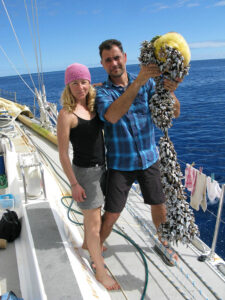
INDIAN OCEAN — Officials believe they're narrowing down the search for the debris from missing Malaysia Airlines Flight 370, but all they've found is trash.
Santa Monica resident Marcus Eriksen has sailed through the area and he's not surprised
The plane went missing on March 8 triggering an international search for the passengers and an explanation. Authorities believe the flight crashed into the southern Indian Ocean.
Eriksen has sailed through all five of the world's gyres — large rotating ocean currents — and seen the massive trash patches they draw in, including the ones that are hampering searchers.
"We saw lots of old fishing nets and buoys and bottles and bags and crates and buckets," he said. "There's a background of all kinds of trash already out there. I knew if they are trying to search for an airplane on the edge of the Indian Ocean gyre they are going to spot other stuff. "
In 2009, Eriksen was so disturbed by the floating and submerged trash piles that he founded 5 Gyres, a nonprofit organization that educates the masses about the problem. Today he leads expeditions through the gyres, documenting the impact of plastics, to raise money and awareness.
Several national television networks have asked Eriksen to weigh in on the search teams' struggles sorting through the trash.
"It's kind of bittersweet that it took a couple hundred lives lost to bring attention to a global catastrophe," he said. "The global issue, it's like a plane wreck in slow-motion."
Searchers keep flagging floating objects that look like plane debris but, thus far, it's always been trash. Searchers traveling by boat may also struggle.
"It is somewhat dangerous to sail through these garbage patches in the sense that entanglement in old fishing gear happens a lot," Eriksen said. "Sucking up plastic bags into your intake valve is dangerous and that happens more often, too."
The most common piece of trash that searchers will have to contend with: fishing buoys, Eriksen said.
"They're designed to last forever in the ocean," he said. "A fishing buoy and a plastic bottle are made of the same stuff. They're both polyethylene. But a fishing buoy is about 100 times thicker. It just lasts."
If officials are correct and the plane did go down on the edge of the Indian Ocean, some of the debris will get stuck in the gyre, he said. Because currents in the area connect to several oceans, the debris could also make its way to Antarctica or the South Pacific or South Atlantic gyres.
"Those aircraft parts could wash up on Easter Island someday if they float that long and go that far," he said.
One solution to the trash problem, Eriksen said, is to reduce the amount of single-use throwaway plastics that don't have any post-consumer value.
"We can't forget that there are 200-plus families that are mourning the loss of somebody and they will never know what happened to them," he said. "That's a massive tragedy that's brought to life this other tragedy that's happening."
For more info visit www.5gyres.org
dave@www.smdp.com








